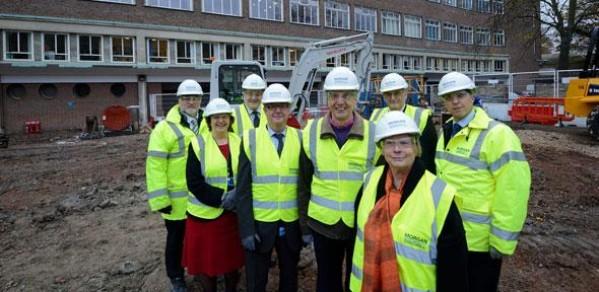
Submitted by Administrator on Thu, 15/01/2015 - 11:02
Sensing tools developed at the Centre for Smart Infrastructure and Construction (CSIC) will provide a central nervous system to the new James Dyson Building creating a hi-tech ‘living lab’. Construction has begun on the building, which will give those working inside it a chance to use their surroundings for research and teaching.
The building has been made possible by a donation of £8 million from the James Dyson Foundation to create a technology hub at the heart of Cambridge that will provide the University of Cambridge’s brightest engineers with some of the world’s most advanced engineering laboratories.
The James Dyson Building will house postgraduates and provide spaces to allow students to share concepts; incubator units will let students conduct intensive research. Specialist knowledge on research strategies and funding advice will be available on-site and the building will support world-leading investigation into areas such as carbon nanotubes, electric vehicles, and efficient internal combustion systems for cars.
At the ground-breaking ceremony for the new technology hub Professor David Cardwell, Head of the Department of Engineering, spoke of the significance of the project to support world-leading research and the benefits of installing instrumentation into the fabric of the building.
“It is a very exciting time for engineering. Modern day construction is extremely impressive. There is so much opportunity to use the fabric of the building in terms of research and generating data and teaching students,” said Professor Cardwell. “The modern way is to bring the building to life and this is a fantastic opportunity. It’s the sign of the future and we will be doing much more of this sort of thing as we move forward. There are very exciting times ahead.”
All three speakers at the ceremony, including Bob Ensch, Area Director at Morgan Sindall, the main contractors for the project, and Angus Stephen, Director of Operations for the University's Estate Management, acknowledged the collaboration with CSIC to instrument the building and the opportunity the new resource will offer to facilitate transformative and life-changing technological breakthroughs.
A number of the foundation piles have been instrumented with CSIC fibre-optic sensors which will provide data, including the temperature gradient of the piles, the temperature of the concrete as it sets and strain measurements as the load changes during construction.
Bob Ensch spoke of the ceremony being a defining moment in the construction process and the implications of instrumenting the piles: “Fibre optics are like the nerves in the body and we are on our way to connecting the building up to create a living lab.”
Additional technologies will be added to the fabric of the four-storey, low-carbon and low-energy building as the project, due to be completed in November 2015, progresses to provide a picture of how the structure is behaving. Dr Mohammed Elshafie, Co-Investigator at CSIC, said: “This is a chance to populate a new building in our own back yard with a range of sensing technologies so, when CSIC is working with students and industry, we can demonstrate our sensing devices operating in real time. Installing CSIC sensing technologies transforms the building from a passive block of material into a living creature. We will be able to ask the building how it is feeling and the building will be able to reply.
Angus Stephen highlighted the innovative features of the structure to create carbon-free electricity and said the James Dyson Building will be the lowest energy user across the University’s estate.
Instrumenting the foundation piles of this building and the additional CSIC technologies added as the project develops further will provide data and information of significant interest to industry.
Jennifer Schooling, Director of CSIC, said: “CSIC collaborates with industry partners to test, develop and deliver technologies to help change the future of infrastructure and construction. Our input to the James Dyson Building is significant and will further strengthen our goal to meet real industry needs.”
Image shows (from left to right): Greg Smith (Site Manager, Morgan Sindall), Professor Dame Ann Dowling (President, Royal Academy of Engineering), Angus Stephen (Director of Operations, Estate Management), Professor David Cardwell (Head of Department of Engineering), Tom and Dore Dyson, Professor Sir Leszek Borysiewicz (The Vice-Chancellor of the University of Cambridge), Bob Ensch (Area Director, Morgan Sindall).
